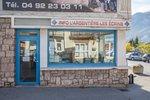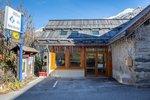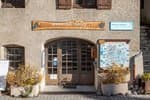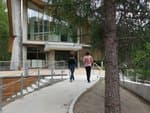Chapelle Saint-Ours circuit (no. 2)
Description
The route starts at the La Rochette housing development. Take the narrow road leading towards Sachas.
- At the intersection with a forest track, carry on along the narrow road leading up to Sachas
- As you enter Sachas, the road turns into a forest track on which you carry on uphill
- At the next intersection, ignore the track running uphill to the right and start to descend, continuing straight ahead
- After the Oratoire Saint-Ours, stay on the main road which leads down to Prelles
- When you come to a mountain stream, you will find a narrow road which you follow through the hamlet
- At the cemetery, turn left and follow the track and the GR route
- At the intersection with the road, pick up the route along which you climbed uphill and return to the starting point
- Departure : La Rochette retail centre (near the Lidl supermarket), Saint-Martin-de-Queyrières
- Arrival : La Rochette retail centre (near the Lidl supermarket), Saint-Martin-de-Queyrières
- Towns crossed : Saint-Martin-de-Queyrières
Altimetric profile
Recommandations
Rescue services contact details: Secours Montagne(Mountain Rescue): +33 (0)4 92 22 22 22 or 112
Take your litter home
Do not take shortcuts across pasturelandInformation desks
23 Avenue de la République, 05120 L'Argentière-La Bessée
Les Alberts, 05290 Puy Saint Vincent 1400 m
Place de l'Eglise, 05340 Vallouise
Vallouise Park house
, 05290 Vallouise
Information, documentation, models, exhibitions, screenings, product sales and works of the Park. Guided tours for school, reservation required. The new Park House opened in Vallouise since June 1, and offers visitors an interactive permanent exhibition inviting to explore the area and its heritage. A temporary exhibition space will allow a renewed offer. Finally, the device is completed by an audiovisual room to organize screenings and conferences Free admission. All animations of the Park are free unless otherwise stated.
Transport
Public transport >> www.pacamobilite.fr
Consider car-sharing >> www.blablacar.fr
Access and parking
Parking :
9 points of interest
 Architecture
ArchitectureThe chapel of Saint-Jacques-de-Prelles
The chapel of Saint-Jacques-de-Prelles was built in the Middle Ages, in 1502, on the ancient pilgrims' way from Italy to Santiago de Compostella. It is surmounted by an arcade bell tower, decorated at the top with blind arcades with pointed arches. A number of wall paintings depicting historical episodes adorn the interior of the chapel, likely dating from the fifteenth century. They were restored in 1955. This chapel was listed as a Historical Monument in 1906 and it contains objects also listed as Historical Monuments, such as the bell which dates from 1639 or the eighteenth century silver, gold and brass ciborium. History
HistoryThe GR 653D
The GR 653D is the Via Domitia. It is the second stage of the pilgrims' way to Santiago de Compostella, the Way of Saint James. This Grande Randonnée follows the route of the Via Domitia, an ancient Roman road built from 118 BC onwards. It linked Italy to the Iberian Peninsula, crossing Narbonese Gaul. 20 days should be allowed to travel its 459 kilometres of paths. Flora
FloraThe field maple
This is the smallest member of the family of forest maples, growing to a height of 8 to 15 metres. It can live for up to 150 years. Its leaves have five round lobes; they are winged with wings sticking out in opposite directions. It is not fussy as to the dampness of the soil and it can withstand cold temperatures and drought. It is also an excellent bee forage plant, which can be enhanced by the proximity of a hive. Architecture
ArchitectureThe chapel of Saint-Claude
The chapel of Saint-Claude was built at an altitude of 1,350 metres in the locality known as Sachas to the north-east of Prelles, on the edge of the municipality of Puy-Saint-André. It has been dated to the eighteenth and nineteenth century at the latest, and appears on the Napoleonic cadastre. It is of elongated plan construction with a flat chevet and a single nave, made up of two vaulted spans of arrises (sharp edges formed by the meeting of two surfaces). The earlier gable is surmounted by a wooden steeple with a hipped roof. It is included on the General Inventory of the Cultural Heritage. Fauna
FaunaThe red fox
With a very dog-like silhouette, the red fox is easily recognisable by its long bushy tail, but also by its long muzzle and large pointed ears with black tips. So it cannot be confused with any other species in France. It owes its name simply to the colour of its coat which is predominantly red. This species is ubiquitous. In fact, it frequents very varied habitats thanks to its diverse diet. It is therefore found over a large part of the territory.
 Fauna
FaunaThe great tit
The great tit is one of the biggest in the family. It is easily recognisable by its yellow underparts with a black median covert, its shiny black head and white cheeks. It has quite an extensive song repertoire, all very beautiful and charming, in particular its finch-like « pinc-pinc », its chattering « ti tuui » and its cheerful « si yutti yutti » . It is present over a large proportion of the territory, in all kinds of tree-covered areas, from boreal forests to gardens. Vernacular heritage
Vernacular heritageThe oratory of Saint-Ours
Erected in the hamlet of Prelles at an altitude of 1,400 metres, this oratory overlooks and watches over the Durance valley. It resembles a small rectangular niche closed off by a glazed wooden door, in which a statue of the Virgin Mary and a metal cross have been placed. But who was this saint? Known as Saint Ursus in English, he was a monk who was born in Ireland and travelled to this region where his evangelisation and help for the poor left a lasting mark on the population. Vernacular heritage
Vernacular heritagePrelles
Stop to admire Prelles, a hamlet situated within the municipality of Saint-Martin-de-Queyrières on the right-hand bank of the Durance. It is a former area of meadows, as its name suggests (“meadows” being pré in French). It is connected to the village via an ancient bridge called the Pont Roux which was destroyed by the Resistance during the Second World War, now replaced. One of the biggest hamlets in the municipality, it is divided into several districts and has numerous buildings marking the history of the region. Flora
FloraThe common ash
This is one of the most common trees, provided the ground is relatively cool. It is characterised by its pinnate leaves, that is to say, made up of several segments, and in winter is can be recognised by its large black leaf buds. The ash was extremely important in times past: its foliage was used to feed cattle and its hard, flexible wood was used to make a variety of objects such as tool handles.
Source

Report a problem or an error
If you have found an error on this page or if you have noticed any problems during your hike, please report them to us here:




